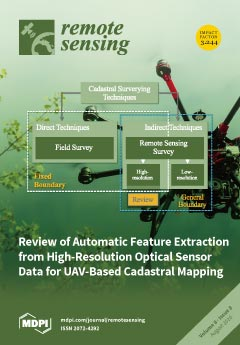Physically-based radiative transfer models (RTMs) help understand the interactions of radiation with vegetation and atmosphere. However, advanced RTMs can be computationally burdensome, which makes them impractical in many real applications, especially when many state conditions and model couplings need to be studied. To
[...] Read more.
Physically-based radiative transfer models (RTMs) help understand the interactions of radiation with vegetation and atmosphere. However, advanced RTMs can be computationally burdensome, which makes them impractical in many real applications, especially when many state conditions and model couplings need to be studied. To overcome this problem, it is proposed to substitute RTMs through surrogate meta-models also named
emulators. Emulators approximate the functioning of RTMs through statistical learning regression methods, and can open many new applications because of their computational efficiency and outstanding accuracy. Emulators allow fast global sensitivity analysis (GSA) studies on advanced, computationally expensive RTMs. As a proof-of-concept, three machine learning regression algorithms (MLRAs) were tested to function as emulators for the leaf RTM PROSPECT-4, the canopy RTM PROSAIL, and the computationally expensive atmospheric RTM MODTRAN5. Selected MLRAs were: kernel ridge regression (KRR), neural networks (NN) and Gaussian processes regression (GPR). For each RTM, 500 simulations were generated for training and validation. The majority of MLRAs were excellently validated to function as emulators with relative errors well below 0.2%. The emulators were then put into a GSA scheme and compared against GSA results as generated by original PROSPECT-4 and PROSAIL runs. NN and GPR emulators delivered identical GSA results, while processing speed compared to the original RTMs doubled for PROSPECT-4 and tripled for PROSAIL. Having the emulator-GSA concept successfully tested, for six MODTRAN5 atmospheric transfer functions (outputs), i.e., direct and diffuse at-surface solar irradiance (
,
), direct and diffuse upward transmittance (
,
), spherical albedo (
S) and path radiance (
), the most accurate MLRA’s were subsequently applied as emulator into the GSA scheme. The sensitivity analysis along the 400–2500 nm spectral range took no more than a few minutes on a contemporary computer—in comparison, the same analysis in the original MODTRAN5 would have taken over a month. Key atmospheric drivers were identified, which are on the one hand aerosol optical properties, i.e., aerosol optical thickness (AOT), Angstrom coefficient (AMS) and scattering asymmetry variable (G), mostly driving diffuse atmospheric components,
and
; and those affected by atmospheric scattering,
and
S. On the other hand, as expected, AOT, AMS and columnar water vapor (CWV) in the absorption regions mostly drive
and
atmospheric functions. The presented emulation schemes showed very promising results in replacing costly RTMs, and we think they can contribute to the adoption of machine learning techniques in remote sensing and environmental applications.
Full article





